
Jamie770
-
Posts
78 -
Joined
-
Last visited
Content Type
Profiles
Forums
Blogs
Gallery
Events
Store
Posts posted by Jamie770
-
-
I attach pics of a Jersey white helmet - not a genuine 'issued' helmet (presumably it's too early to see these being retained by retiring officers!) but constructed from parts from the same manufacturer so this should match the issued item.
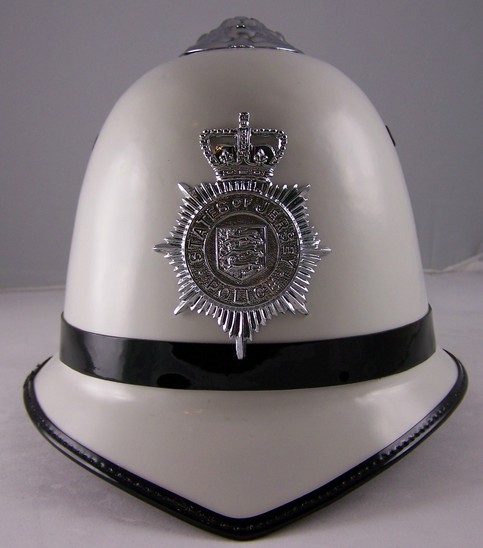
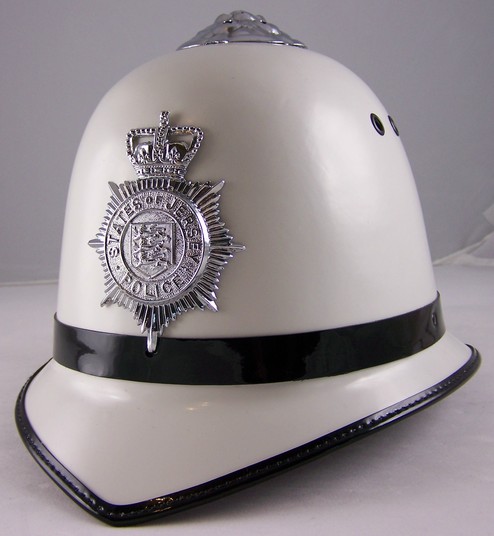 0
0 -
Hi Craig,
Definately a rare helmet, possibly unique as I suspect that it is the bandmaster's helmet.
Normal Met band helmets that I have seen only had a plain cloth centre strip similar to my Durham helmet.
0 -
As an example of a Band helmet, I attach a pic of my Durham Constabulary:
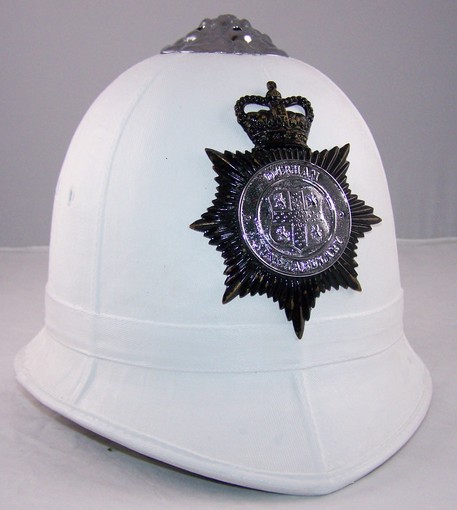 0
0 -
As far as I am aware, white helmets were worn for broadly three roles:
a) Beat duties - i.e. Brighton, Souhend on Sea etc
b) Traffic point duties - i.e. Leeds, Birmingham etc
c) The Band - i.e. Metropolitan, Durham etc
I attach a pic of my Stockport Borough which may be off interest:
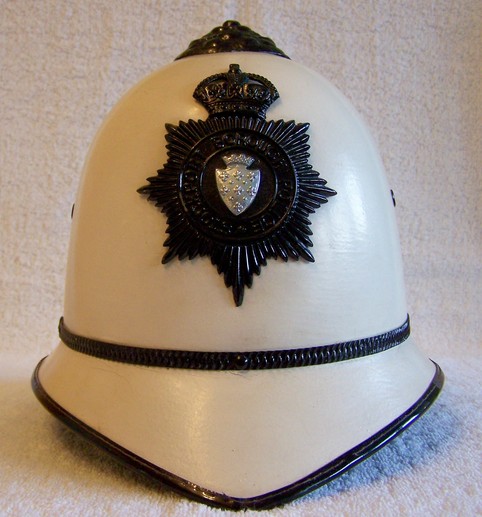
As an example of a traffic helmet, I attach a pic of my Leeds City:
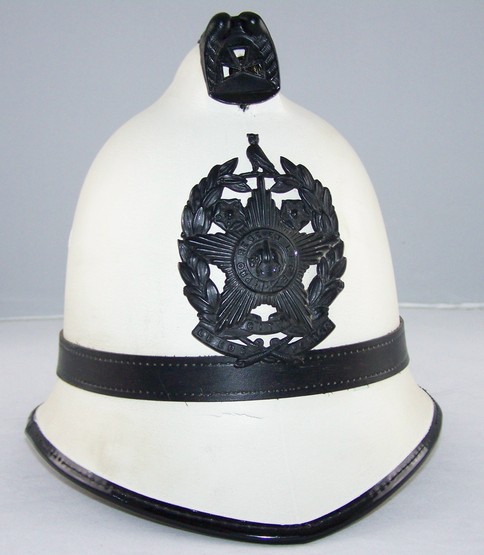 0
0 -
Hi Jamie, thanks so much for the photo's, my mind is at ease! My helmet is essentially identical to yours aside from some subtle variances which could realistically be a result of either a different makers interpretation of the same specification, minor specification changes over time, or both. The differences are:
1. Mine has no rear vent holes.
2. Mine has a slightly narrower fabric band around the outside of it (about 20mm, same as the strap) whereas yours looks to be wider, possibly about 25mm?
3. The string threaded through the leather sweatband on mine is threaded through every 4th hole in the band, yours looks like it is threaded much closer. (If you look at post#142 on this page, Brian Wolfe posted a photo of the interior of his blue Velocette helmet,) my sweatband is 100% identical to that.
4. I can see some sort of stamp or mark on the sweatband of yours, mine has none.
On the subject of Brian's picture, you will also note that his still has all the cork lining right through the shell of the helmet, whereas yours & mine don't although mine has remains of it. Your helmet looks very nice & original Jamie, unfortunately mine has been re-blancoed at some point which partially obscures the "grain" of the fabric. Would it be fair to say then, that we both have a style of Brighton helmet which is even rarer than the already scarce "foot patrol" white helmets? Cheers, will upgrade my membership and post my pic's soon. By the way, I left Brighton as a 16 year old in 1971 and will be going back for the first time this year in October. I am hoping to go to the Police Museum in Brighton in my travels.
Cheers, Geoff.
Hi Geoff,
I'd agree that the minor differences are likely to be different manufacturers setting the specification slightly differently. The sweatband isn't stamped, its the stick on size label that you're seeing in the photo.
Yes, I'd also agree that we have an unusual variation on the normal style of Brighton white helmet - a good talking point with other collectors as these type of motorcycle helmets aren't very common, even the normal blue cloth versions from other forces.
You'll probably see a lot of changes in Brighton from how you remember it from 1971. I've never been to the Brighton police museum, but I reckon it should be an interesting visit!
Cheers,
Jamie
0 -
I attach here an internal view showing the straps etc

Interestingly, on the Website "My Brighton And Hove" there is a photo of the Police Storeman (Bert) from Brighton police stores with stacks of surrendered white helmets in the background after the amalgamation in the late 60's and if you look closely at the stack that Bert is actually holding, the second helmet from the bottom of the stack has what looks to me very much like a portion of the much wider white riot strap showing under the helmet side brim. Check it out.
That is a good spot! I think you are probably correct - comparing my helmet to the picture, I reckon the sliding keeper which the free end of the fastener goes under can clearly be seen!
Cheers,
Jamie
0 -
Thanks Jamie for the motorcycle helmet theory and I would very much like to see some photos of your own riot strap helmet.
Hi Geoff,
Your helmet certainly sounds fine - as requested I've attached a couple of pics of mine. Interestingly mine was never issued, so has never been whitened. Internally its never been worn. Apologies for the rather poor quality of the photos, they were quickly taken in the kitchen!
I attach a pic of the rear two vent holes, I wouldn't put any great importance if your doesn't have these, they were possibly a manufacturing variation, perhaps on helmets supplied to the force shortly before the amalgamation, which could explain why this one never saw service.

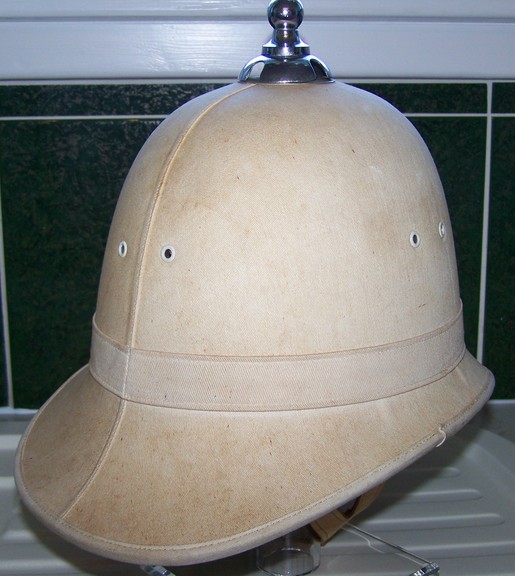 0
0 -
Mervyn,
I have examples of both the Met helmets you describe.
The full size one has the motorcycle strap (the same as the Brighton helmet except in black leather) and is quite strongly reinforced inside. It has two additional eyelet ventilation holes on the rear of the helmet as well as the normal two on either side.
The 'Noddy' helmet is very interesting, being very different from the normal style.
Regarding the Brighton helmet, it is not so strongly reinforced with only an extra layer of fibre material inside the dome, behind the headband. The leather chinstrap is securely fixed and it also has the two rear additional eyelet ventilation holes.
The helmet is well made and looks like it came from the factory like this, it doesn't look like a local modification.
Nick, that certainly looks like a good helmet at Denhams!
0 -
Thanks Nick,
A very good example of the two panel QC helmet for members to compare with your KC
0 -
Hi Nick,
Thanks for this link - but I'm not sure that's an original Brighton helmet.
It's a six panel QC helmet (which I think is unusual) but to my eyes the inside doesn't look right, especially the lining inside the dome being a seperate piece with cuts in it to allow it to be fitted up inside the shell - very reminiscent of the cork liner in early custodian helmets. The thick green packing behind the sweatband also looks different to any other Brighton white that I've ever handled.
I'm not sure what its history is, but it doesn't look like it dates from the 1960's
0 -
Hi Geoff,
My opinions on your queries are:
a) I understand that in the mid 1930's the Home Office in the UK had a policy of trying to standardise police dress within the country. The 'look' they preferred was that worn by the Metropolitan Police in London. Accordingly many forces at this time changed their older 'wreath' style plates to the Mets 'Star' pattern.
b) It is hard to be sure without seeing a picture of your helmet but I believe it could be genuine. In my collection I have a Brighton white helmet with the 'riot' style of chinstrap. From memory (as I don't have it to hand), the chinstrap is made from white leather about 20mm or so wide, attached at the sides and rear of the helmet and with a buckled fastener under the chin. This style of helmet was, I believe, worn by officers riding the low power motorcycle patrols. Some forces used full size helmets with this chinstrap arrangement instead of the 'noddy' style.
Nicks helmet is a fine example of a KC version - these had a slightly higher dome and were 6 panelled. The later QC helmets were 2 panel and weren't quite so high (only a fairly slight difference though).
Hope this helps.
J
0 -
A few unusual white helmets:
Isle of Man Harbour Police:

Birmingham City Police traffic control helmet:
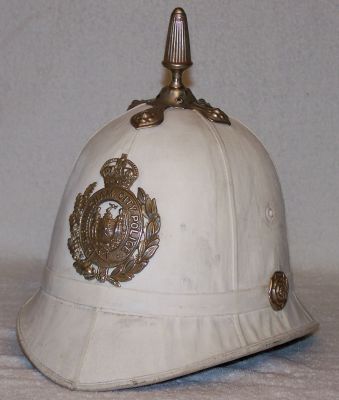
Leeds City Police traffic control helmet:

Stockport Borough Police summer helmet:
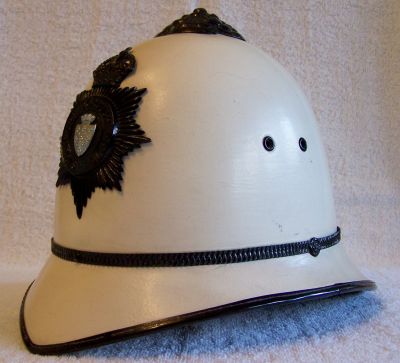 0
0 -
Glasgow City Police normal beat helmet, worn up to the early 1930's before the helmet plate design changed to incorporate the Scottish national police badge.
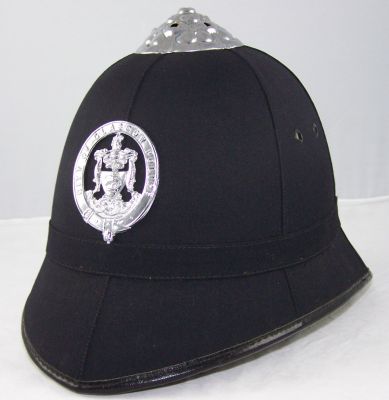 0
0 -
Edinburgh City ceremonial helmets:
Senior officers version:
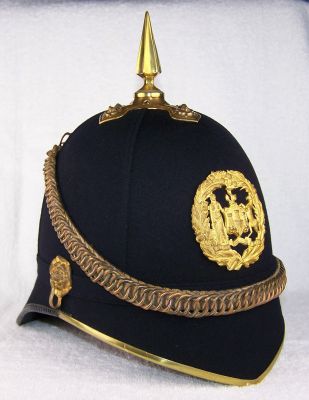
Constables & Sergeants version:
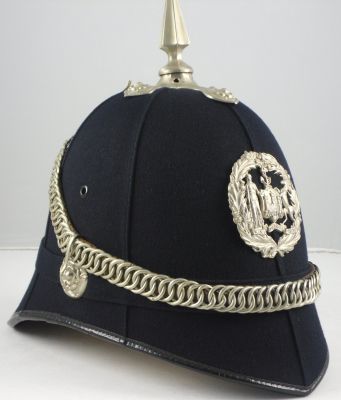 0
0 -
To hopefully add to the topic, I thought I'd add a few pictures of unusual helmets which members might find interesting.
Firstly a very rare Victorian Midlothian Constabulary helmet with unusual Scottish pattern helmet furniture.
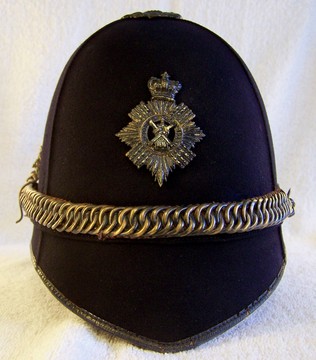

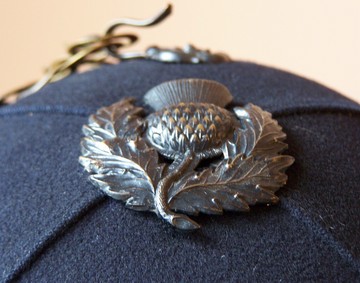 0
0 -
Further to the pictures of straw helmets, Kilmarnock Burgh Police wore them as well during the summer months although they didn't attach a force helmet plate.
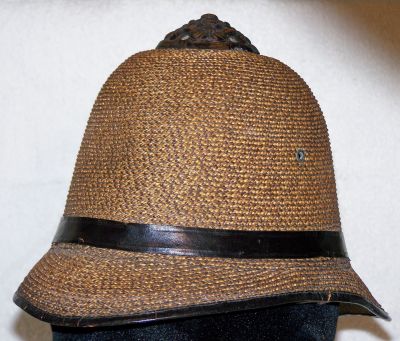 0
0 -
Hi Mervyn,
This is a fabulous uniform - very rare and in excellent condition.
Many thanks for posting the pictures!
0 -
Hi Paul,
Unfortunately I don't currently have any KC OR's helmets in my collection.
However, I have in the past and I don't recall any which had this type of lug on the HP.
I attach a photo showing the normal arrangement - metal rod bent to form an eyelet with the two strands coming together to form a shaft which is butt soldered to the plate.
However, it is difficult to be too definative - there were probably several makers of helmets and plates and whenever you think you have found how something was definately done, another item will turn up which proves that variations existed!
Perhaps someone else will have come across this type of lug but, along with your other reservations, I would be suspicious of this plate.
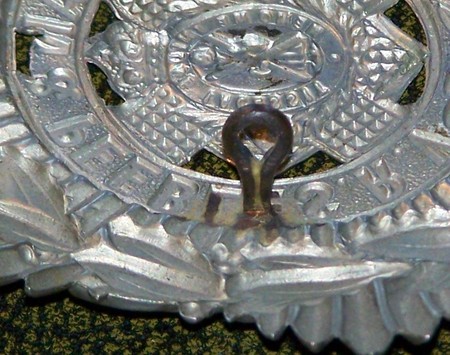 0
0 -
Hi Paul,
From your more detailed photos, I'd probably have to agree that it doesn't look 'right'. I particularly don't like the lugs which are different from the normal style I would have expected to see.
If the seller offered a return guarantee, you will need to consider whether you will wish to use this.
0 -
Hi Paul, As you know, there have been a lot of fake helmet plates produced over the last few years and identifying them can be quite difficult.
This plate looks good - it seems to have a patina of age and I think the design of the central castle is correct for use with a KC backplate. On earlier Essex centres the towers were wider apart and abutted the underside of the Sphinx plinth. However, until you hold it in your hand it will be impossible to finally decide one way or the other.
One method I usually use is to look at how the lugs are attached to the plate. On the genuine plates I have seen they form a butt soldered joint - if there is the presence of extended 'feet' to allow for a bigger soldered joint then I would treat the plate with caution. I attach a pic of a lug (from a modern police helmet plate) which shows the extended feet.
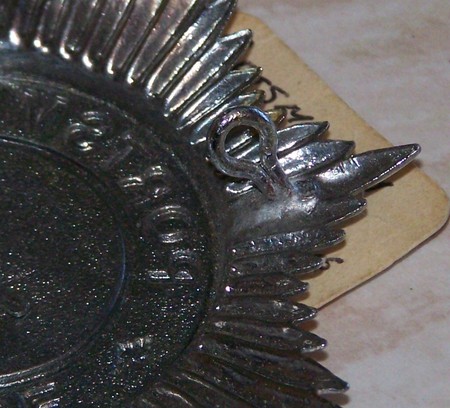
Regarding which lugs penetrate the helmet shell, I have seen many variances of this. I think it came down to who was attaching the helmet plates and their use of the most prominent lugs to accept the retaining pins / leather wedges.
Hope this is of some help.
0 -
Hi Stuart,
The date has no real relevance other than that was when the transition started from QC to KC plates - I would suspect that when helmets were retained for the Tattoos they would have kept back the later versions.
I don't know when the cork was introduced - I've never really studied the feature but I've seen OR's helmets both with and without it. Possibly this varied from manufacturer to manufacturer (?).
To be honest, I don't think it would provide much ventilation. Careful peeling back of the leather head band reveals little ventilation opening with the cork seeming to be more of a 'spacer' to follow the shape of the forehead. Perhaps someone else can cast some more light on this feature or give a different opinion?
The police versions addressed the ventilation issue by introducing side vent grommets to allow passage of air - although some forces like the Royal Irish Constabulary did not have these.
I'm not sure of the dates of the Aldershot Tattoos but I believe they used stocks of full dress, a good proportion of which presumably dated from pre-WW1.
0 -
A police helmet of circa 1910 - 1920 vintage - the side ventilation grommet hole can be seen, although the actual grommet fitting is missing.
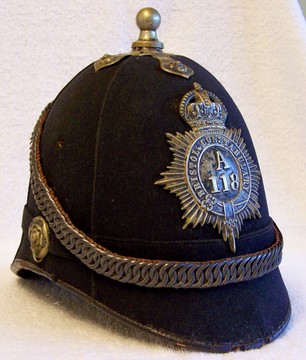 0
0 -
Also for comparison, herewith a photo of the inside of a Victorian Midlothian and Peebles RV Vols helmet
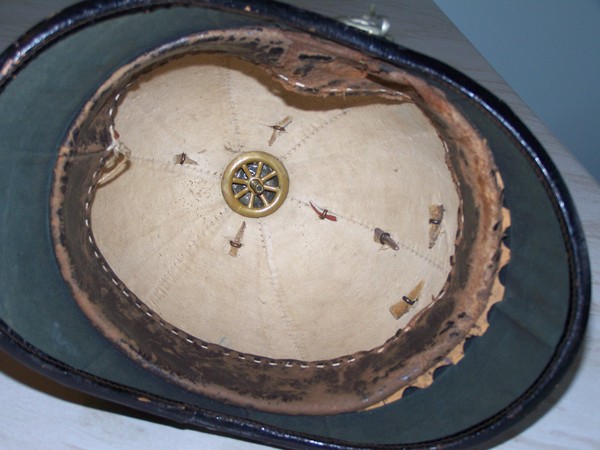 0
0 -
I think that this helmet is a 'marriage' put together of original parts.
The helmet shell looks like an original OR's HSH - whilst early police helmets were similar (and some did have rounded front peaks), the majority would have had ventilation grommets either side.
The metal fittings look original, the two fixing cross base is unusual but I've seen it once or twice before on OR's helmets. I think the spike is correct, having a longer screw thread protruding through the collet is quite common on OR's helmets.
The ear rosettes are of the'cheaper' looking pattern - but the main concern is that they don't match.
On the plus side, it has retained its shape well and with carefull cleaning and some restoration it could make a fair display piece as being representative of the HSH style - I suppose its desirability would depend on price and what you are looking for.
I suspect it is a post 1902 helmet subsequently used at the Aldershot Tattoo - the large ink stain is quite possibly covering the Tattoo stamp. There is a lot of damage to the cork body behind the helmet plate, probably caused by repeated removal and refixing of different plates.
For comparison I attach an internal photo of a Victorian Lanarkshire Rifle Vols helmet (unusual in having screw lugs on the otherwise OR's pattern cross base)
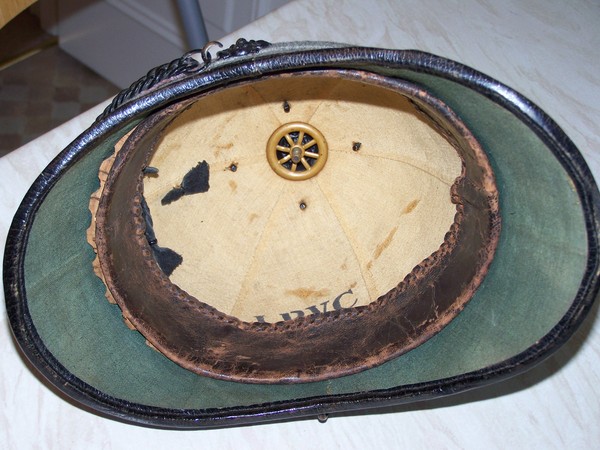 0
0


White Duty Helmets
in Great Britain: Mervyn Mitton's British & Colonial Police Forces
Posted
Hi Jermil,
Thanks for this info - I'd been a little uneasy about the helmet plate, the corners of the crown had looked slightly different from those in the pictures I'd seen.
I'll keep an eye out for one of the new plates although I doubt they will appear on the collecting market for a while.